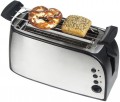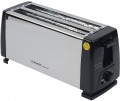Power
Electrical power consumed by the device during operation. A more
powerful appliance spends less time cooking to readiness; at the same time, the high consumption of electricity is often offset by the speed of cooking (in other words, the device simply does not have time to "eat" a lot of energy). However, such a device will also cost more. Therefore, it makes sense to specifically look for such a technique mainly in cases where “every extra second matters” — for example, if a toaster is bought for a cafe or diner where you need to cook quickly and in large quantities.
Also note that a device with a large capacity will inevitably require a higher power.
Roasting degree
The number of roasting levels provided in the device.
This parameter is relevant primarily for models with step adjustment (see "Control"). Each degree of roasting corresponds to a certain fixed power setting in them. Accordingly, the more such steps, the more options the user has, the more accurately he can set the preparing mode. At the same time, we note that even for an advanced model, 8 – 9 steps are considered quite sufficient, a larger number is extremely rare. And for simple household use, more than 5 – 6 steps are rarely required — unless you plan to cook according to specific recipes.
Note that the number of degrees of roasting can also be indicated for equipment with smooth adjustment. However, these are not fixed settings, but only auxiliary divisions on the adjustment scale; they are applied in order to make it easier to navigate for the user. So you can not pay much attention to this moment when choosing a device with smooth adjustment.
Features
—
Auto-centering. Function found in toasters (see "Type"). Thanks to auto-centering, each slice of bread is placed in the centre of the compartment during cooking, at the same distance from the heating elements, and toasted on both sides equally.
—
Heating. Operating mode of the toaster (see "Type"), in which the product is not fried, but only slightly warmed up. This function can be useful, for example, to reheat previously cooked toast.
—
Defrosting. Toasters often include a specialized function, found in their features (see Type), for toasting frozen bread. Frozen bread cannot be directly fried, as it requires defrosting first. The toaster's defrost mode provides a convenient way to defrost frozen bread quickly and efficiently.
—
High lift. Possibility of lifting cooked toast above the standard height. This feature is useful when toasting small slices of bread that would otherwise be difficult to remove from a hot toaster.
—
One-sided frying. Possibility to toast on one side only. This function can be useful, for example, when making toast from a piece of bread — on the one hand, it no longer needs to be fried.
— Readiness indicator. An external indicator, typically in the form of a light, is used to signal the completion of cooking in certain toasters
...(see Type). It's worth noting that in traditional toasters, this function is relatively uncommon. Instead, the completion of toasting is indicated by the toast popping up from the compartments accompanied by a noticeable click and sometimes an additional sound.
— Overheat protection. Safety system that automatically turns off the device when the heating element or body reaches a critical temperature. This allows user to avoid unpleasant consequences, ranging from a breakdown of the device and ending with a fire.In box
—
Grid for heating buns. Device for warming baked goods that cannot fit inside the toaster's main compartment, like rolls or croissants. It is installed on top of the toaster and uses hot air generated by the heating elements to heat the food.
—
Sandwich grill. The toaster is equipped with a unique grill-like grate that enables the frying of sandwiches. This miniature grill securely holds the sandwich on both sides, preventing any ingredients from falling out. By placing the sandwich on this grate, it can be cooked in the toaster until it reaches the desired consistency.
—
Sandwich mold. Sandwich makers are equipped with distinctive triangular notches on their plates, specifically designed for making classic closed sandwiches. However, these versatile notches can also be used for baking and other purposes. These types of nozzles are commonly found in sandwich makers and can also come included with waffle makers and similar devices.
—
Waffle maker. A device for making waffles has the form of two plates with a characteristic relief surface (for example, “in a square”). Such a device can be equipped not only with the actual devices for cooking waffles (see "Type"), but also with other types of kitchen appliances — in particular, sandwich makers.
— A waffle maker designed specifically for making Vienne
...se waffles has a distinct heating element design. The resulting baked goods from the waffle maker resemble large, thick, and fluffy wafers. Unlike traditional waffles, Viennese waffles have a softer texture. They are commonly used as a base for making pies or served with additional creams, powdered sugar, and other toppings.
— A waffle maker designed for making thin waffles features a unique heating element that produces thin cakes with small waffle patterns. These thin wafers are commonly used to create tubes filled with boiled condensed milk (toffee) or other types of cream. Thin waffles serve as a base for making multi-layer waffles, pies, cakes, and various other dishes.
— Grill. A device consisting of plates, or a single plate, with a ribbed surface. It is designed to leave distinctive grilled stripes on the food when heated. Grills are commonly found in sandwich makers and occasionally in other devices with similar designs (see "Type"). This feature is primarily used for light frying and heating purposes, such as making hot sandwiches or stuffed pita bread. While it is theoretically possible to use the grill for more substantial tasks like cooking steaks, not all models offer this capability.
— For nuts. A specialized attachment for making nut-shaped cakes is equipped with recesses for half of the nuts on one side, while the other side acts as a press to form the "shells." This type of nozzle is commonly found in hazelnut makers, but it can also be present in other kitchen appliances for creating various nut-shaped treats.
— For cupcakes. Cupcakes in this case usually mean muffins — products of a relatively small size, with a rounded top and a slightly tapering base. In addition to cake makers, nozzles of this type are found among sandwich makers (see "Type").
— For donuts. Nozzles of this kind typically feature ring-shaped notches, specifically designed for baking distinctive donuts or "bagels." However, there are alternative options available, and certain devices can be equipped with multiple attachments to create donuts in various shapes. These types of nozzles are utilized not only in donut makers but also in certain cupcake makers and sandwich makers.
— For an omelette. The traditional shape of omelettes is typically semicircular, and the recesses in this type of nozzle also have a similar shape. It's worth noting that with some clever techniques using such a nozzle, you can prepare other dishes as well, such as calzone or pasties. The versatility of the nozzle allows for experimenting with different fillings and ingredients to create a variety of delicious meals.
— For cookies. Replaceable plates or attachments for baking a variety of shaped cookies. Sandwich makers, some muffin makers and waffle irons can be equipped with similar shapes.
In addition to those listed above, modern kitchen devices can be equipped with other types of nozzles.Crumb pallet
The presence in the design of the toaster
of a removable pallet for bread crumbs. Crumbs inevitably form during the process of toasting, and the presence of a special pallet makes cleaning them much easier — just remove the pallet, shake it out and put it back. In models without such an opportunity, to clean the crumbs, you must either sweep them off the table, where they spill out through special openings or disassemble the device — both options are not very convenient.
Material
The main material used in the body of the device.
—
Plastic. Plastic is an affordable and practical material that offers functionality in various applications. Its lightweight nature makes it suitable for complex shapes, and it can be easily colored to match any desired aesthetic. Additionally, plastic's low thermal conductivity helps conserve energy and reduces the risk of burns from touching the device's exterior. While plastic may not match the strength and scratch resistance of metal, these aspects primarily impact the device's appearance rather than its critical functionality. One significant drawback is plastic's limited heat resistance, which necessitates additional thermal insulation and makes it less reliable in case of malfunctions. Plastic is found across different price ranges, but it is particularly popular in relatively inexpensive devices.
—
Steel. Steel cases are known for their exceptional strength and reliability, surpassing plastic cases in scratch resistance and ability to withstand high temperatures. The solid appearance of steel adds to its appeal. However, steel is considerably more expensive, making all-metal cases more commonly found in mid-range and high-end devices. In budget-friendly devices, steel is often used as an additional decorative coating on top of plastic or only in specific areas of the case, typically near the heating element where enhanced durabil
...ity is required.
— Glass. When it comes to kitchen appliances, it is impractical to construct the entire case out of glass. Instead, glass is typically used for separate parts, often the front and back panels, while the rest of the body is made of metal and/or plastic. Glass inserts provide a unique aesthetic appeal, allowing a glimpse of the device's internal components without the need to open the case. However, this design is expensive and lacks practical advantages compared to more traditional materials. Even tempered and heat-resistant glass remains fragile. As a result, such cases are extremely rare and usually found in designer models.
